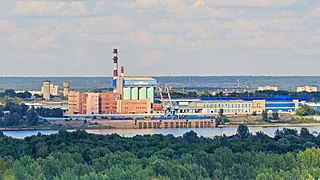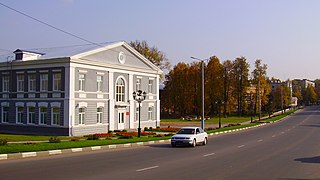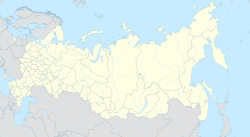
Gorodets is a town and the administrative center of Gorodetsky District in Nizhny Novgorod Oblast, Russia, located on the left bank of the Volga River, 53 kilometers (33 mi) northwest of Nizhny Novgorod, the administrative center of the oblast. Population: 30,658 (2010 Census); 32,442 (2002 Census); 34,210 (1989 Soviet census); 34,000 (1970).

Bor is a town in Nizhny Novgorod Oblast, Russia, located on the left (northern) bank of the Volga River, across from Nizhny Novgorod. The two cities are connected by bridges built in 1965 and 2017, and by ferry service. Population: 78,372 (2021 Census)78,058 (2010 Census); 61,525 (2002 Census); 64,512 (1989 Soviet census); 51,000 (1969).

Balakhna is a town and the administrative center of Balakhninsky District in Nizhny Novgorod Oblast, Russia, located on the right bank of the Volga River, 32 kilometers (20 mi) north of Nizhny Novgorod, the administrative center of the oblast. Population: 51,519 (2010 Census); 57,338 (2002 Census); 32,133 (1989 Soviet census); 33,500 (1968).

Pavlovo, also known as Pavlovo-na-Oke, is a town and the administrative center of Pavlovsky District in Nizhny Novgorod Oblast, Russia, located on the right bank of Oka River in the northwestern part of the Volga Upland. As of the 2010 Census, its population was 60,698.

Vetluga is a town and the administrative center of Vetluzhsky District in Nizhny Novgorod Oblast, Russia, located on the right bank of the Vetluga River, after which the town is named. Population: 8,954 (2010 Census); 9,641 (2002 Census); 10,190 (1989 Soviet census).

Lyskovo is a town and the administrative center of Lyskovsky District in Nizhny Novgorod Oblast, Russia, located on the southern side of the Volga River, opposite the mouth of the Kerzhenets River, 90 kilometers (56 mi) southeast of Nizhny Novgorod, the administrative center of the oblast. Population: 21,880 (2010 Census); 23,901 (2002 Census); 25,029 (1989 Soviet census).

Kstovsky District is an administrative district (raion), one of the forty in Nizhny Novgorod Oblast, Russia. Municipally, it is incorporated as Kstovsky Municipal District. It is located in the center of the oblast. The area of the district is 1,225 square kilometers (473 sq mi). Its administrative center is the town of Kstovo. Population: 112,823 ; 46,759 (2002 Census); 47,917 (1989 Soviet census). The population of Kstovo accounts for 59.1% of the district's total population.

Bogorodsk is a town and the administrative center of Bogorodsky District in Nizhny Novgorod Oblast, Russia, located 43 kilometers (27 mi) southwest of Nizhny Novgorod, the administrative center of the oblast. Population: 35,499 (2010 Census); 37,095 (2002 Census); 38,401 (1989 Soviet census).

Volodarsk is a town and the administrative center of Volodarsky District in Nizhny Novgorod Oblast, Russia, located on the Seyma River 50 kilometers (31 mi) west of Nizhny Novgorod, the administrative center of the oblast. Population: 9,928 (2010 Census); 10,989 (2002 Census); 11,034 (1989 Soviet census).

Zavolzhye is a town in Gorodetsky District of Nizhny Novgorod Oblast, Russia, located on the right bank of the Volga River, opposite Gorodets, the administrative centre of the district, and 56 kilometers (35 mi) northwest of Nizhny Novgorod, the administrative center of the oblast. Population: 40,460 (2010 Census); 43,971 (2002 Census); 44,630 (1989 Soviet census).

Lukoyanov is a town and the administrative center of Lukoyanovsky District in Nizhny Novgorod Oblast, Russia, located on the Tyosha River, 173 kilometers (107 mi) south of Nizhny Novgorod, the administrative center of the oblast. Population: 14,951 (2010 Census); 12,856 (2002 Census); 12,276 (1989 Soviet census).

Vorsma is a town in Pavlovsky District of Nizhny Novgorod Oblast, Russia, located on the Kishma River, 71 kilometers (44 mi) southwest of Nizhny Novgorod, the administrative center of the oblast. Population: 11,620 (2010 Census); 12,629 (2002 Census); 13,648 (1989 Soviet census).

Navashino is a town in Nizhny Novgorod Oblast, Russia, located on a branch of the Oka River, 10 km east of Murom and 158 kilometers (98 mi) southwest of Nizhny Novgorod. As of the 2010 Census, its population was 16,416.

Uren is a town and the administrative center of Urensky District in Nizhny Novgorod Oblast, Russia, located on the right bank of the Usta River, 183 kilometers (114 mi) northeast of Nizhny Novgorod, the administrative center of the oblast. It has population: 12,304 (2010 Census); 12,558 (2002 Census); 13,560 (1989 Soviet census).

Chkalovsk is a town in Nizhny Novgorod Oblast, Russia, located on the right bank of the Volga River, 95 kilometers (59 mi) northwest of Nizhny Novgorod, the administrative center of the oblast. As of the 2010 Census, its population was 12,368.

Perevoz is a town and the administrative center of Perevozsky District in Nizhny Novgorod Oblast, Russia, located on the Pyana River, 120 kilometers (75 mi) southeast of Nizhny Novgorod, the administrative center of the oblast. Population: 9,201 (2010 Census); 9,386 (2002 Census); 8,313 (1989 Soviet census).

Knyaginino is a town and the administrative center of Knyagininsky District in Nizhny Novgorod Oblast, Russia, located on the Imza River, 107 kilometers (66 mi) southeast of Nizhny Novgorod, the administrative center of the oblast. Population: 6,708 (2010 Census); 6,838 (2002 Census); 6,374 (1989 Soviet census).

Bolshoye Zagarino is a village (selo) in Vachsky District of Nizhny Novgorod Oblast, Russia. Municipally, the village is a part of Chulkovsky Rural Settlement, the administrative center of which is the village of Chulkovo.
Sosnovsky Urban Settlement or Sosnovskoye Urban Settlement is the name of several municipal formations in Russia.

Kulebaki is a town in Nizhny Novgorod Oblast, Russia, located 188 kilometers (117 mi) southwest of Nizhny Novgorod, the administrative center of the oblast. As of the 2010 Census, its population was 35,759.





























